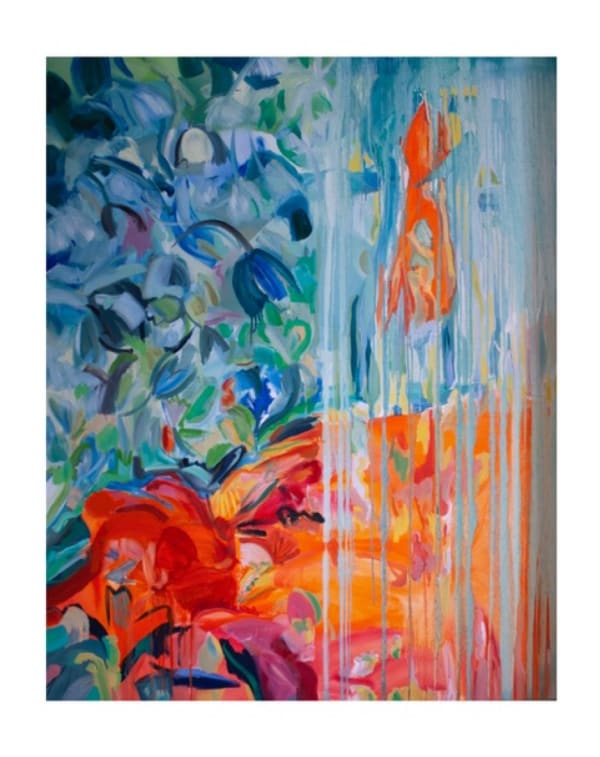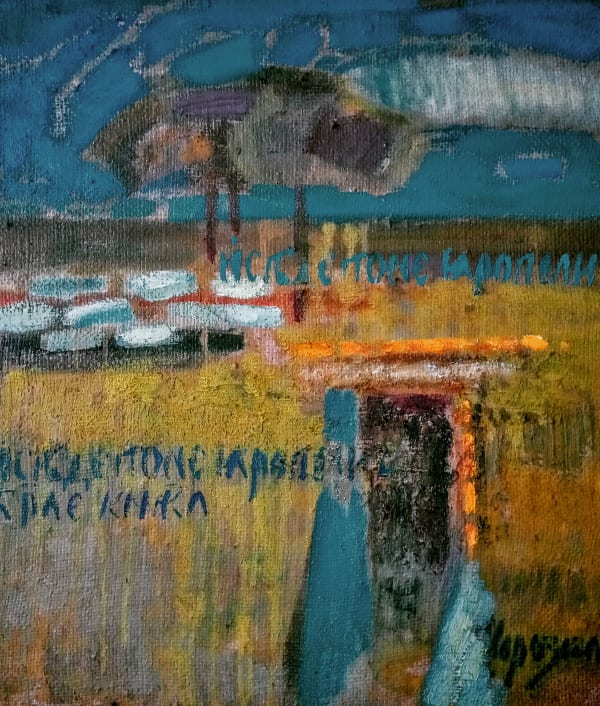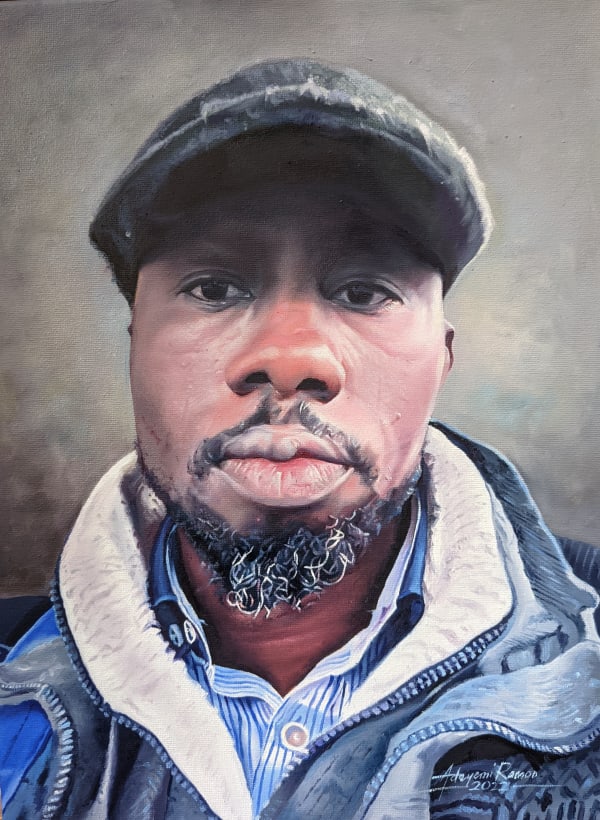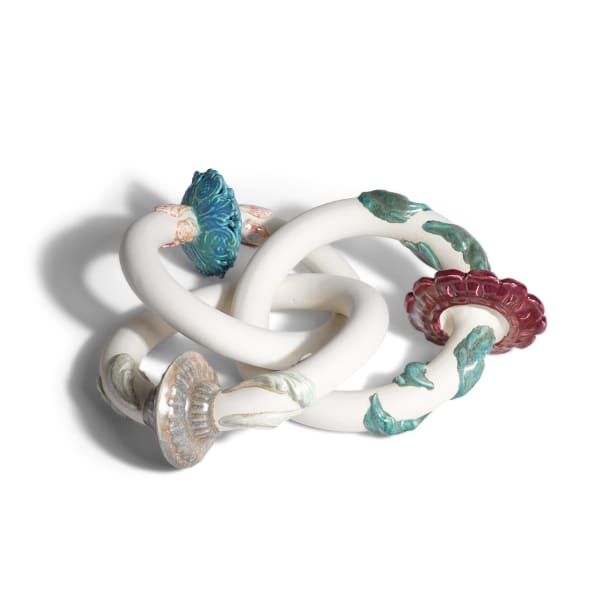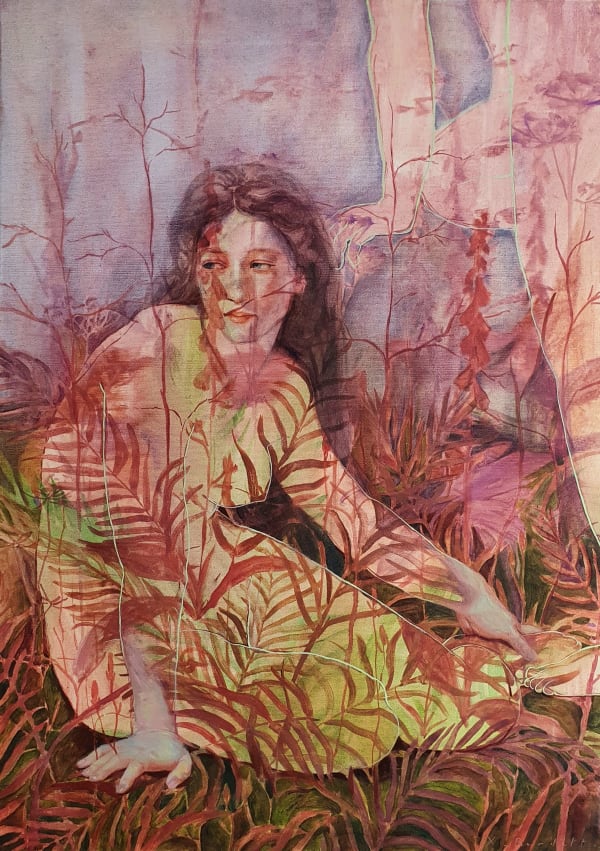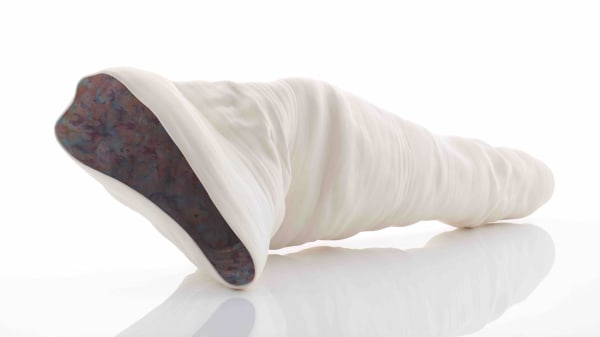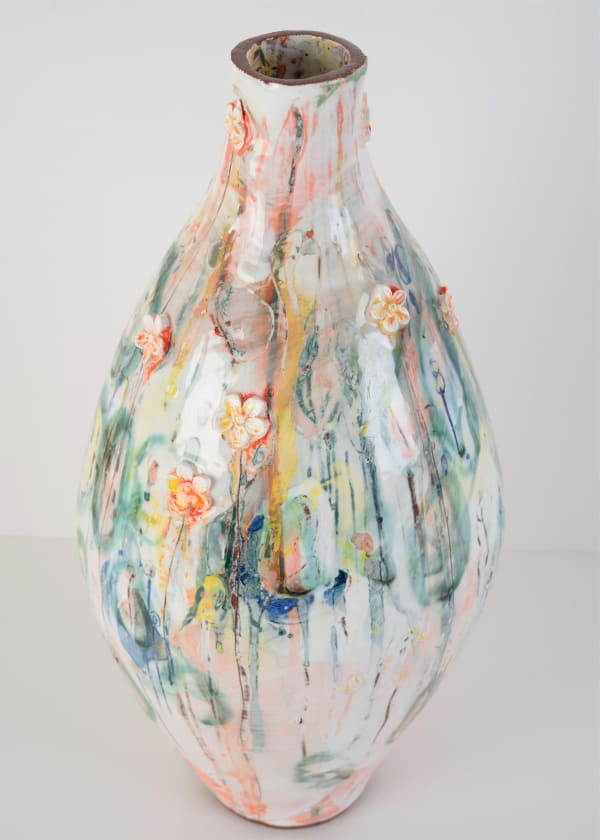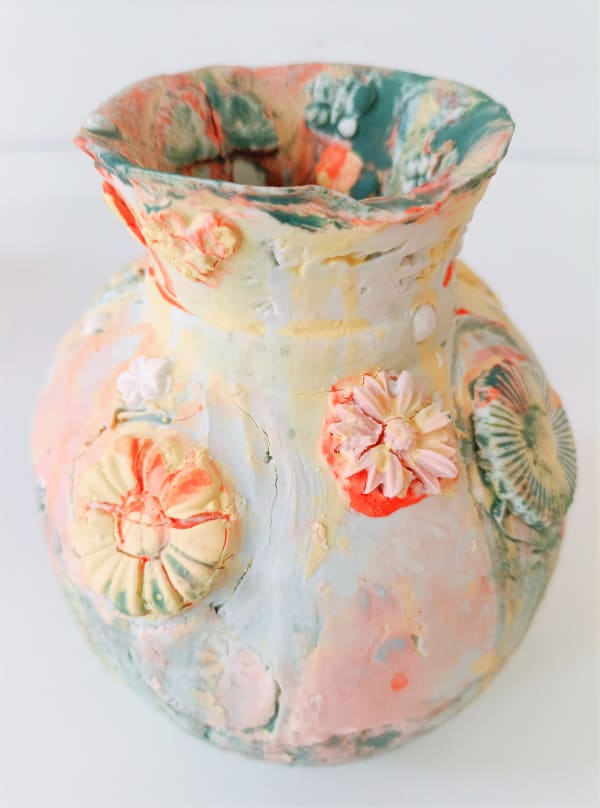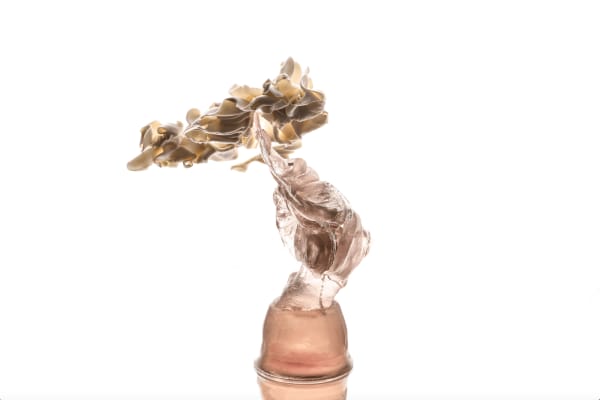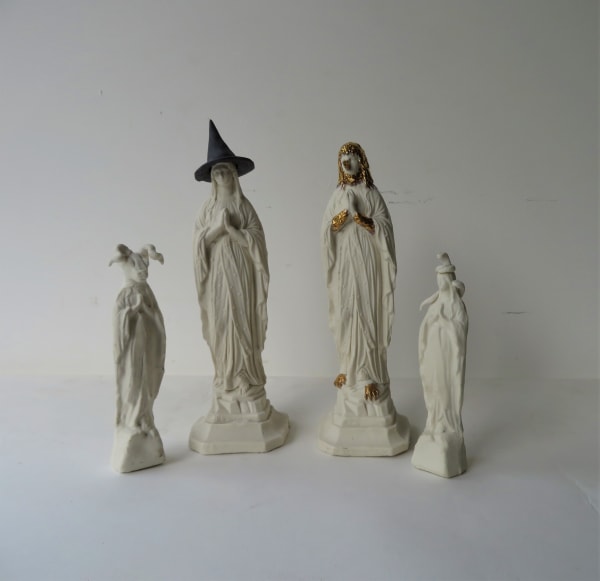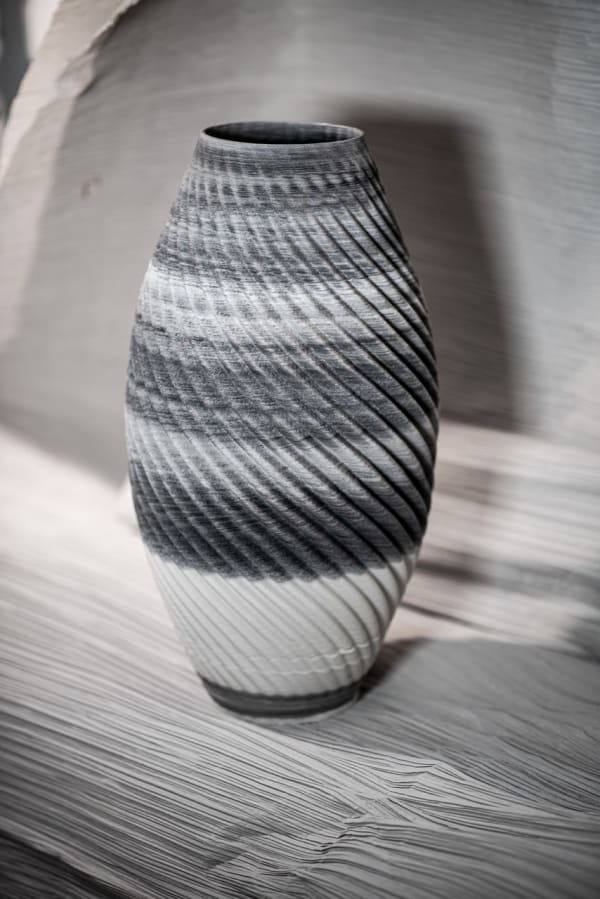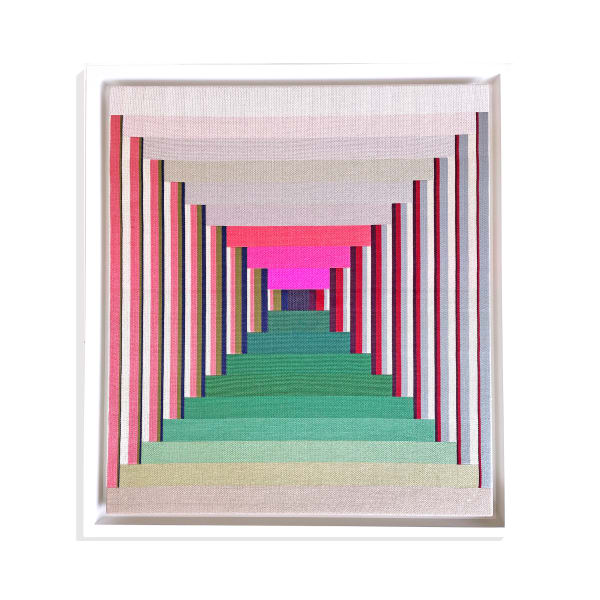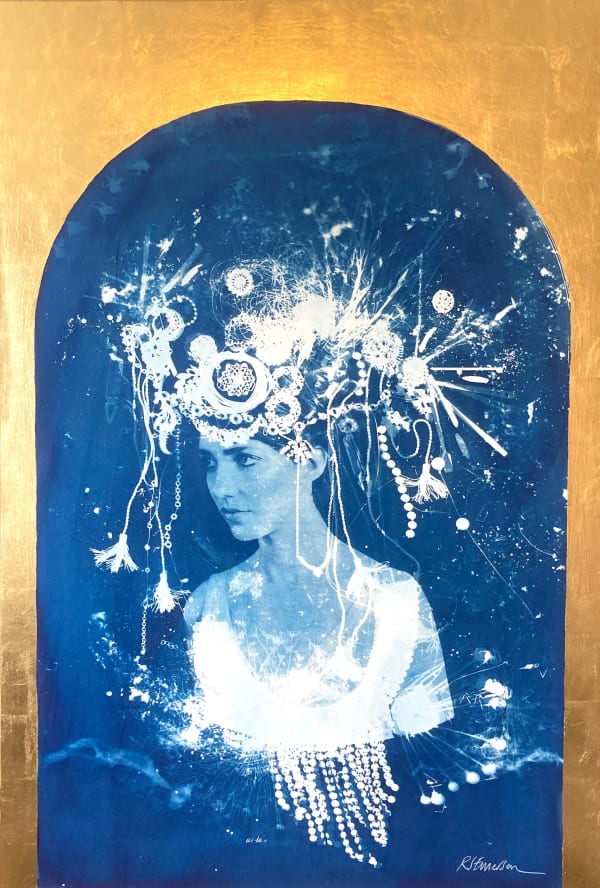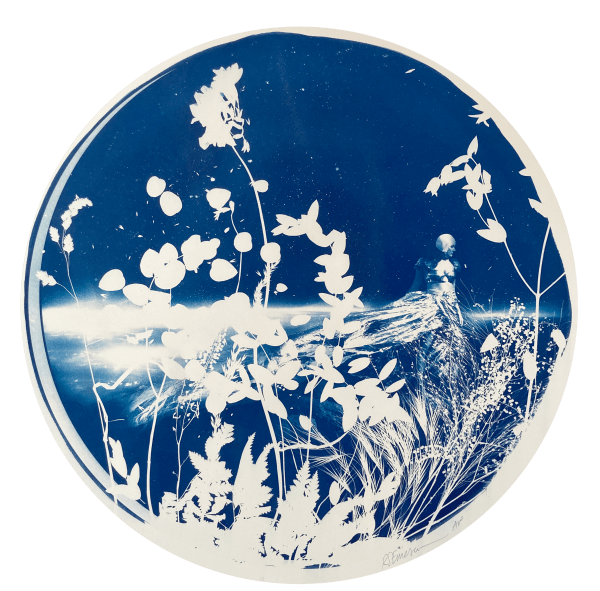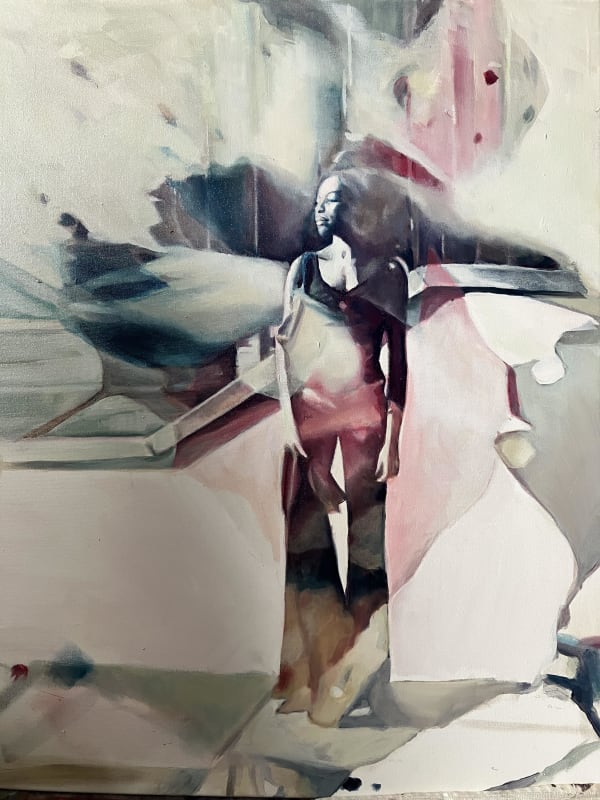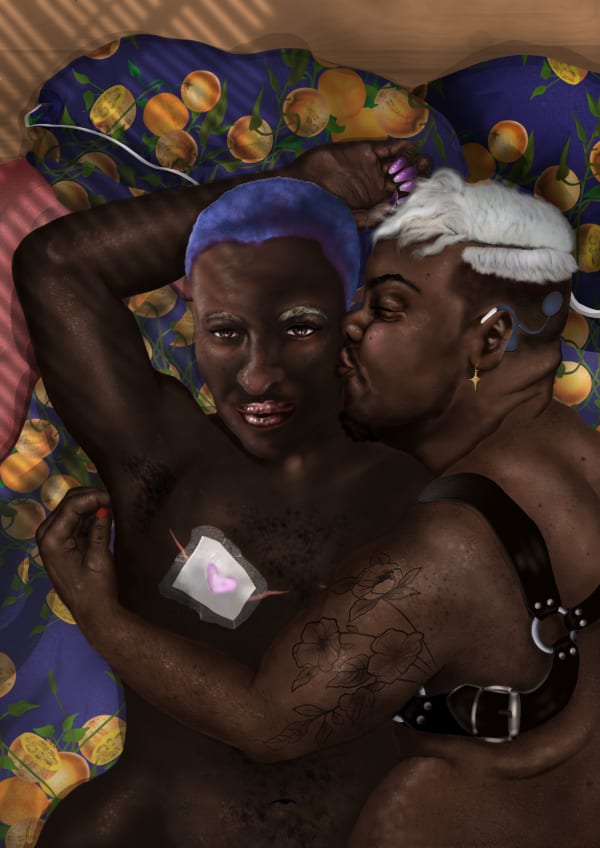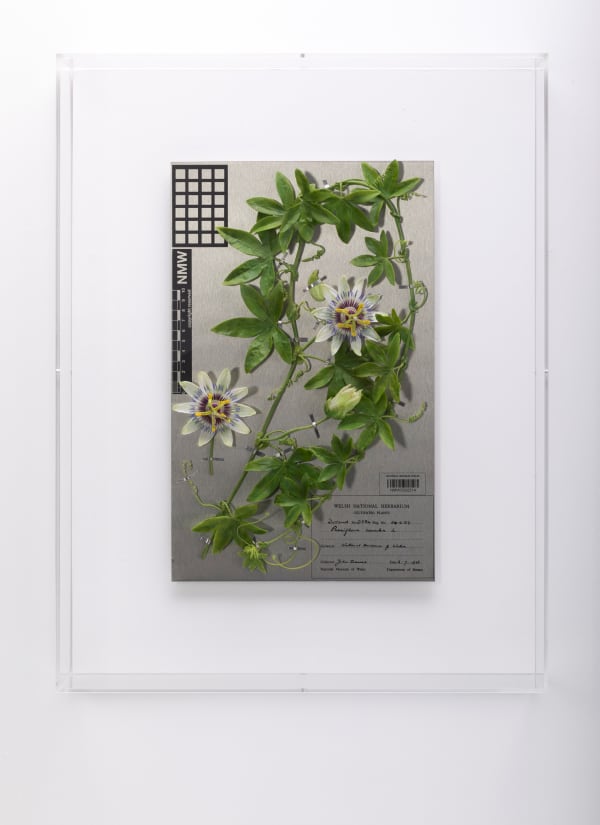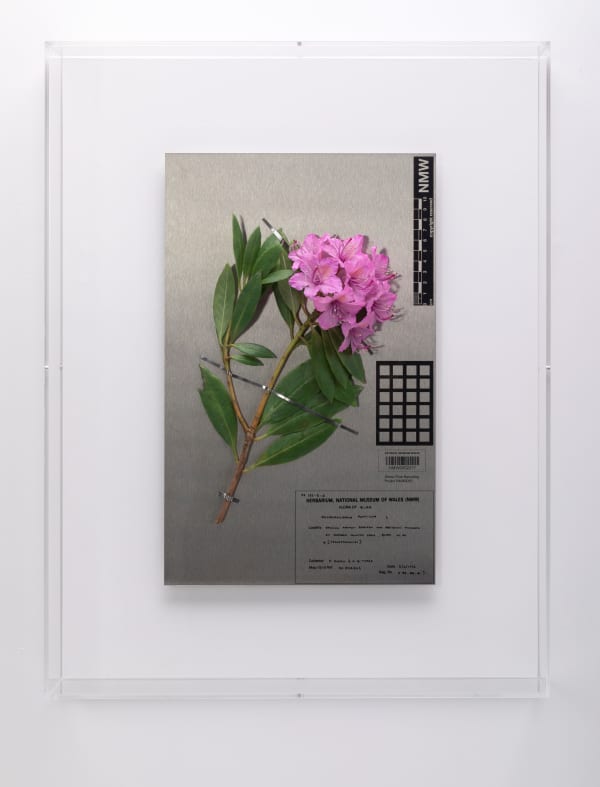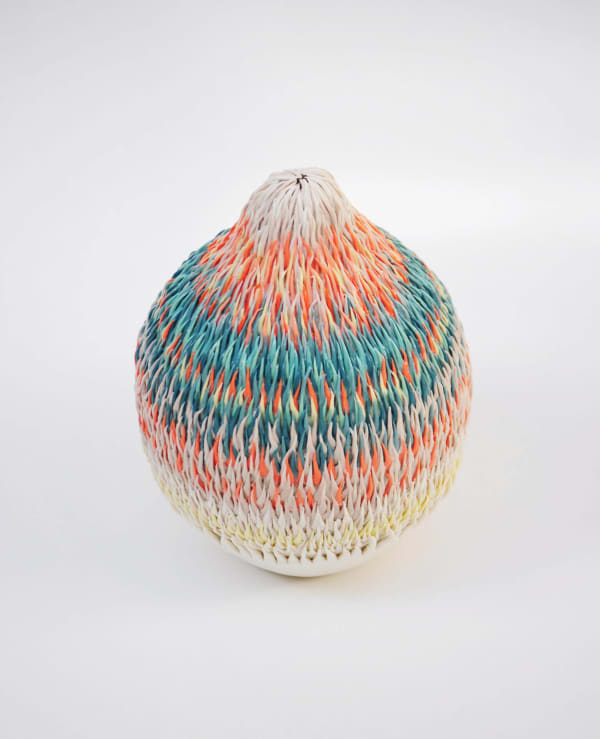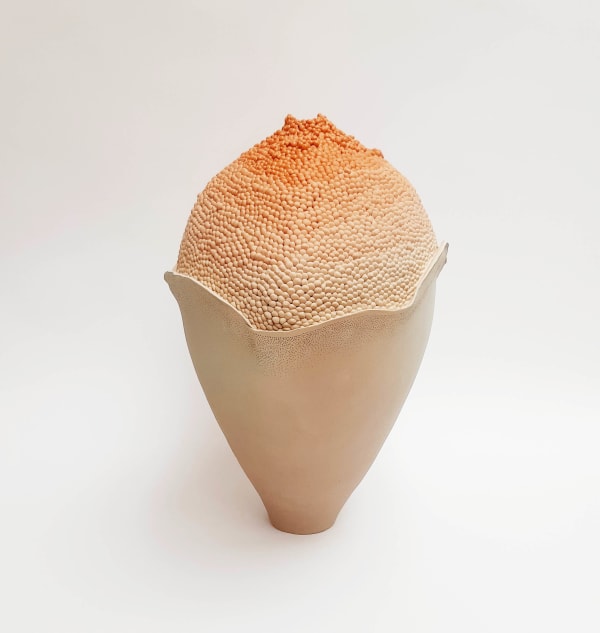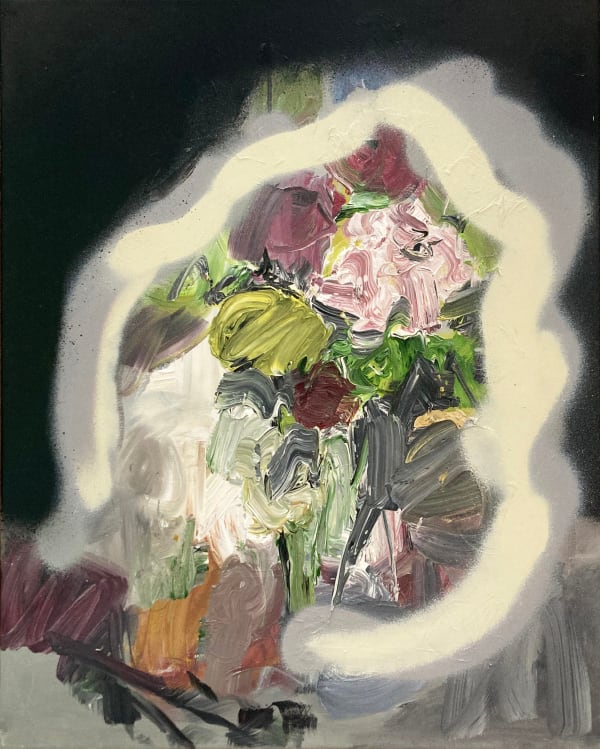-
 Jemima MurphyBold Reprisal, 2022Oil on Canvas120 x 90 cm
Jemima MurphyBold Reprisal, 2022Oil on Canvas120 x 90 cm
47 1/4 x 35 1/2 in.Courtesy of Cynthia Corbett GalleryCopyright The Artist -
 Jemima MurphyBlue Heart, 2022Oil on Canvas150 x 120 cm
Jemima MurphyBlue Heart, 2022Oil on Canvas150 x 120 cm
59 x 47 1/4 in.SOLDCourtesy of Cynthia Corbett GalleryCopyright The Artist -
 Jemima MurphyDownpour, 2022oil on canvas149.9 x 120 cm
Jemima MurphyDownpour, 2022oil on canvas149.9 x 120 cm
59 x 47 1/4 in.SOLDCourtesy of Cynthia Corbett GalleryCopyright The Artist -
 Ronan McGeoughSunset Studio, 2020Oil on canvas70 x 100 cm
Ronan McGeoughSunset Studio, 2020Oil on canvas70 x 100 cm
27 1/2 x 39 1/4 in.Courtesy of Cynthia Corbett GalleryCopyright The Artist -
 Elaine Woo MacGregorBathers in Avon, 2022Acrylic on Linen
Elaine Woo MacGregorBathers in Avon, 2022Acrylic on Linen
Framed:
63 x 53 x 3.5 cm
24 3/4 x 20 3/4 x 1 1/2 in.Courtesy The Artist and The Gallery -
 Felix ChesherMorning Tea, 2020Oil on Canvas61 x 46 cm
Felix ChesherMorning Tea, 2020Oil on Canvas61 x 46 cm
24 x 18 in.
Framed size:
65 x 50 cmSOLDCourtesy of Cynthia Corbett GalleryCopyright The Artist -
 Freya NashEternal Dance (A person, a thing, a shadow), 2022Oil and graphite on canvas140 x 100 cm
Freya NashEternal Dance (A person, a thing, a shadow), 2022Oil and graphite on canvas140 x 100 cm
55 x 39 1/4 in.Courtesy of Cynthia Corbett GalleryCopyright The Artist -
 Olga MorozovaFortifications Of The City, 2022Oil, sackcloth, trench sand70 x 60 cm
Olga MorozovaFortifications Of The City, 2022Oil, sackcloth, trench sand70 x 60 cm
27 1/2 x 23 1/2 in.SOLDCourtesy of Cynthia Corbett GalleryCopyright The Artist -
 Ramon Omolaja AdeyemiSelf Portrait, 2022With courtesy of Rudolph/Blume CollectionOil on canvas
Ramon Omolaja AdeyemiSelf Portrait, 2022With courtesy of Rudolph/Blume CollectionOil on canvas
40 x 30 cm
15 3/4 x 11 3/4 in.
With courtesy of Rudolph/Blume CollectionSOLDCourtesy of Cynthia Corbett GalleryCopyright The Artist -
 Kate QuinlanTriskele V, 2022Porcelain, glaze.35 x 35 x 11 cm
Kate QuinlanTriskele V, 2022Porcelain, glaze.35 x 35 x 11 cm
13 3/4 x 13 3/4 x 4 1/4 in.Courtesy of Cynthia Corbett GalleryCopyright The Artist -
 Xanthe BurdettThe Two Bathers, 2022Oil on canvas70 x 50 cm
Xanthe BurdettThe Two Bathers, 2022Oil on canvas70 x 50 cm
27 1/2 x 19 3/4 in.SOLDCourtesy of Cynthia Corbett GalleryCopyright The Artist -
 Zoe WeisselbergCollapse, 2022Thrown paper porcelain, glaze25 x 80 cm
Zoe WeisselbergCollapse, 2022Thrown paper porcelain, glaze25 x 80 cm
9 3/4 x 31 1/2 in.Courtesy of Cynthia Corbett GalleryCopyright The Artist -
 Andree AdleyALPHERIC, 2021Wood, plaster, re cycled jewels, glass crystals35 x 15 x 5 cm
Andree AdleyALPHERIC, 2021Wood, plaster, re cycled jewels, glass crystals35 x 15 x 5 cm
13 3/4 x 6 x 2 in.Courtesy of Cynthia Corbett GalleryCopyright The Artist -
 Stephannie CartwrightPapalio, 2022Grogged terracotta, porcelain slips, oxides and mason stains38 x 16 cm
Stephannie CartwrightPapalio, 2022Grogged terracotta, porcelain slips, oxides and mason stains38 x 16 cm
15 x 6 1/4 in.Courtesy of Cynthia Corbett GalleryCopyright The Artist -
 Stephannie CartwrightDaisy Makeig-Jones Pot, 2022Coloured porcelain, ceramic shards, oxides and mason stains17 x 11 cm
Stephannie CartwrightDaisy Makeig-Jones Pot, 2022Coloured porcelain, ceramic shards, oxides and mason stains17 x 11 cm
6 3/4 x 4 1/4 in.SOLDCourtesy of Cynthia Corbett GalleryCopyright The Artist -
 Valerie BernardiniSwirl and Foam, 2022Glass and Ceramic16 x 13 x 10 cm
Valerie BernardiniSwirl and Foam, 2022Glass and Ceramic16 x 13 x 10 cm
6 1/4 x 5 x 4 in.Courtesy of Cynthia Corbett GalleryCopyright The Artist -
 Valerie Bernardiniwashed ashore, 2022Glass and ceramic12 x 14 x 10 cm
Valerie Bernardiniwashed ashore, 2022Glass and ceramic12 x 14 x 10 cm
4 3/4 x 5 1/2 x 4 in.Courtesy of Cynthia Corbett GalleryCopyright The Artist -
 Camilla HanneyAltered Madonnas, 2020cast and handbuilt porcelain, gold lustreLarge figures:
Camilla HanneyAltered Madonnas, 2020cast and handbuilt porcelain, gold lustreLarge figures:
35 x 7 cm
13 3/4 x 2 3/4 in.
Courtesy of Cynthia Corbett GalleryCopyright The Artist -
 Camilla HanneyAltered Madonnas, 2020cast and handbuilt porcelain, gold lustreSmall figures:
Camilla HanneyAltered Madonnas, 2020cast and handbuilt porcelain, gold lustreSmall figures:
17 x 4 cm
6 3/4 x 1 1/2 in.Courtesy of Cynthia Corbett GalleryCopyright The Artist -
 Jane WardOf the Sea and Land, 2022digital print, paint, ink on canvas70 x 90 cm
Jane WardOf the Sea and Land, 2022digital print, paint, ink on canvas70 x 90 cm
27 1/2 x 35 1/2 in.Courtesy of Cynthia Corbett GalleryCopyright The Artist -
 Jane WardUntitled , 2022digital print, paint, ink on paper22.5 x 30 cm
Jane WardUntitled , 2022digital print, paint, ink on paper22.5 x 30 cm
8 3/4 x 11 3/4 in.Edition of 10SOLDCourtesy of Cynthia Corbett GalleryCopyright The Artist -
 Ryan BarrettRTB-1, 2021White Porcelain24 x 20 cm
Ryan BarrettRTB-1, 2021White Porcelain24 x 20 cm
9 1/2 x 7 3/4 in.SOLDCourtesy of Cynthia Corbett GalleryCopyright The Artist -
 Ryan BarrettRTB - 2, 2021Porcelain with mixed oxides44 x 28 cm
Ryan BarrettRTB - 2, 2021Porcelain with mixed oxides44 x 28 cm
17 1/4 x 11 in.Courtesy of Cynthia Corbett GalleryCopyright The Artist -
 Ryan BarrettRTB-0211, 2021White Porcelain53 x 20 cm
Ryan BarrettRTB-0211, 2021White Porcelain53 x 20 cm
20 3/4 x 7 3/4 in.Courtesy of Cynthia Corbett GalleryCopyright The Artist -
 Ryan BarrettRTB-112, 2021A mix of Black and White Porcelain.51 x 21 cm
Ryan BarrettRTB-112, 2021A mix of Black and White Porcelain.51 x 21 cm
20 x 8 1/4 in.Courtesy of Cynthia Corbett GalleryCopyright The Artist -
 Margo SelbyCARRE SERIES- Work 5, 2022Handwoven stretched lampas panel, made on a 32 shaft Leclerc Weavebird loom medium: Cotton and silk, stretched and framed in painted wood121.5 x 112.5 x 3.5 cm
Margo SelbyCARRE SERIES- Work 5, 2022Handwoven stretched lampas panel, made on a 32 shaft Leclerc Weavebird loom medium: Cotton and silk, stretched and framed in painted wood121.5 x 112.5 x 3.5 cm
47 3/4 x 44 1/4 x 1 1/2 in.SOLDCourtesy of Cynthia Corbett GalleryCopyright The Artist -
 Margo SelbyVEXILLUM STUDY, Work 2, 2021Tencel, cotton and silk72.2 x 65.2 cm
Margo SelbyVEXILLUM STUDY, Work 2, 2021Tencel, cotton and silk72.2 x 65.2 cm
28 1/2 x 25 3/4 in.Courtesy of Cynthia Corbett GalleryCopyright The Artist -
 Rosie EmersonAthena, 2022Cyanotype with 22crt Gold Leaf on Paper113 x 78.7 cm
Rosie EmersonAthena, 2022Cyanotype with 22crt Gold Leaf on Paper113 x 78.7 cm
44 1/2 x 31 in.Unique Original, With one Artist ProofSOLDCourtesy of Cynthia Corbett GalleryCopyright The Artist -
 Rosie EmersonHorizon, 2022Cyanotype on Paper60 x 60 cm
Rosie EmersonHorizon, 2022Cyanotype on Paper60 x 60 cm
23 1/2 x 23 1/2 in.
Framed size:
74 cm x 74 cm x 7 cmArtist ProofCourtesy of Cynthia Corbett GalleryCopyright The Artist -
 Alison MulroyRe-entry, 2022Oil on canvas96 x 76 x 3 cm
Alison MulroyRe-entry, 2022Oil on canvas96 x 76 x 3 cm
37 3/4 x 30 x 1 1/4 in.Courtesy of Cynthia Corbett GalleryCopyright The Artist -
 Jason KattenhornLove TRANScends, 2020Fine Art Print, on Matt 200gsm High White conservation digital paper.29.7 x 21 cm
Jason KattenhornLove TRANScends, 2020Fine Art Print, on Matt 200gsm High White conservation digital paper.29.7 x 21 cm
11 3/4 x 8 1/4 in.Edition of 1/20Courtesy of Cynthia Corbett GalleryCopyright The Artist -
 Annette Marie TownsendAliens 1956, 2021Courtesy of Ruup & FormBeeswax collected from the beehives on the roof of National Museum Cardiff, artists’ beeswax, paraffin wax, tinned copper wire, tissue paper, cotton thread, artists’ pigments, acrylic paint, acrylic varnish. Mounted on a stainless steel plate with stainless steel strips.41.5 x 26 cm
Annette Marie TownsendAliens 1956, 2021Courtesy of Ruup & FormBeeswax collected from the beehives on the roof of National Museum Cardiff, artists’ beeswax, paraffin wax, tinned copper wire, tissue paper, cotton thread, artists’ pigments, acrylic paint, acrylic varnish. Mounted on a stainless steel plate with stainless steel strips.41.5 x 26 cm
16 1/4 x 10 1/4 in.
Framed:
60 x 46 x 12 cmCourtesy of Cynthia Corbett GalleryCopyright The Artist -
 Annette Marie TownsendAliens 1992, 2021Courtesy of Ruup & FormBeeswax collected from the beehives on the roof of National Museum Cardiff, artists’ beeswax, paraffin wax, tinned copper wire, tissue paper, cotton thread, artists’ pigments, acrylic paint, acrylic varnish. Mounted on a stainless steel plate with stainless steel strips.41.5 x 26 cm
Annette Marie TownsendAliens 1992, 2021Courtesy of Ruup & FormBeeswax collected from the beehives on the roof of National Museum Cardiff, artists’ beeswax, paraffin wax, tinned copper wire, tissue paper, cotton thread, artists’ pigments, acrylic paint, acrylic varnish. Mounted on a stainless steel plate with stainless steel strips.41.5 x 26 cm
16 1/4 x 10 1/4 in.
Framed:
60 x 46 x 12 cmCourtesy of Cynthia Corbett GalleryCopyright The Artist -
 Maria Diletta RondoniGemma/Red and blue bud, 2022Hand-built porcelain25 x 28 cm
Maria Diletta RondoniGemma/Red and blue bud, 2022Hand-built porcelain25 x 28 cm
9 3/4 x 11 in.Courtesy of Cynthia Corbett GalleryCopyright The Artist -
 Maria Diletta RondoniRainbow Bud, 2022Hand Built Porcelain16 x 24 cm
Maria Diletta RondoniRainbow Bud, 2022Hand Built Porcelain16 x 24 cm
6 1/4 x 9 1/2 in.Courtesy of Cynthia Corbett GalleryCopyright The Artist -
 Maria Diletta RondoniBig Fruit , 2022Hand built Stoneware39 x 25 x 41 cm
Maria Diletta RondoniBig Fruit , 2022Hand built Stoneware39 x 25 x 41 cm
15 1/4 x 9 3/4 x 16 1/4 in.Courtesy of Cynthia Corbett GalleryCopyright The Artist -
 Miranda BoultonInto the Groove, 2021Oil and acrylic spray paint on canvas78 x 63 x 2 cm
Miranda BoultonInto the Groove, 2021Oil and acrylic spray paint on canvas78 x 63 x 2 cm
30 3/4 x 24 3/4 x 3/4 in.Courtesy of Cynthia Corbett GalleryCopyright The Artist -
 Miranda BoultonThe World is Ours I, 2021Oil and acrylic spray paint on canvas52 x 42 x 2 cm
Miranda BoultonThe World is Ours I, 2021Oil and acrylic spray paint on canvas52 x 42 x 2 cm
20 1/2 x 16 1/2 x 3/4 in.Courtesy of Cynthia Corbett GalleryCopyright The Artist -
 Miranda Boulton18th Century Girl, 2022Oil and acrylic spray paint on canvas60 x 50 cm
Miranda Boulton18th Century Girl, 2022Oil and acrylic spray paint on canvas60 x 50 cm
23 1/2 x 19 3/4 in.SOLDCourtesy of Cynthia Corbett GalleryCopyright The Artist
Rosie Emerson
Rose Emerson (born 1981, Dorset) is an award winning contemporary artist. Having studied and lived in London for ten years, she is now based West Sussex. Emerson’s work is collected and exhibited both in the UK and internationally. She was awarded the Bridgeman Studio Award; participated in the Young Masters Art Prize; exhibited her work in Sphinx Gallery, London; and created a new world record for the largest Cyanotype photograph.
Emerson has undertaken a number of private and commercial commissions, working with brands including Harvey Nichols, The Ivy Club, Sony, Triumph Underwear, Redbull, P&O Cruises, and Annoushka jewellery. Her artwork has also been featured in Vogue, Harpers Bazaar, Another Magazine, The Financial Times Magazine and The Sunday Times Style Magazine.
Emerson creates unapologetically feminine works on paper, which embrace aesthetics and engenders wonder. Her subjects reference historical and contemporary archetypes, such as Artemis and today’s super model. Influenced by the drama of the Baroque and the ethereal qualities of the Pre Raphaelites, she employs lighting, costumes and prop making, as well as printmaking and painting, to create her otherworldly one-off pieces.
Jemima Murphy
Jemima Murphy (born 1992, London) studied BA Hons in Russian Language at the University of Bristol (2010-2014) and is currently completing the MA Fine Art at City & Guild’s of London Art School (2022-2023). Her artworks explore emotional memory and affectivity through reimagined landscapes and places she has been. She examines past experiences, relationships, and how love, loss, fears, desires and regrets are constantly reevaluated and reinterpreted. Her paintings occupy the liminal space between reality, memory and desire. Murphy’s paintings leave space for the viewer’s own interpretation, eliciting an array of emotions dependent on the viewer’s emotional state.
Inspired by the Fauves, Murphy’s work embodies a Neo-Fauvist and expressionist style to create her immersive landscapes and foliage. By painting ambiguous locations, Murphy hopes to impart a feeling though her colourful dreamscapes. Very often the works are zoomed in to capture the fleeting and ephemeral nature of a memory - almost like flashes or corner fragments of a moment. Murphy is fascinated in how memories can be idolised until they become the epitome of fantasy and desire.
Elaine Woo MacGregor
Elaine Woo MacGregor (born 1981, Edinburgh), a born Chinese artist, studied Fine Art at the Glasgow School of Art. She now lives in Linlithgow, West Lothian, and works in Glasgow and Edinburgh. She has exhibited in galleries in Edinburgh, Glasgow, London, Cambridge and abroad. Her work, ‘Hotel No.4' is housed in the public galleries collection, The Atkinson Art Gallery, Southport. Woo MacGregor was an Artist in Residence in Amhuinnsuidhe Castle Estate, Isle of Harris in 2010, Vermont Studio Center, U.S.A in 2009 and Guizhou Art Academy, China in 2008.
She has been teaching at the Glasgow School of Art since 2008 and the Centre for Lifelong Learning at Strathclyde University since 2009, as an art lecturer. In 2019 she founded Linlithgow Art School, specialising in drawing and painting classes for both children and adults.
Woo MacGregor’s work encapsulates the world seen through the eyes of a cross cultural artist. She uses eclectic mark making and imagery to create atmospheric and theatrical scenes. Although her painted stories are often fictitious, elements of the picture are based on real people, places and things. Her work has been shown in the U.K, U.S.A, Australia and Thailand.
Miranda Boulton
Miranda Boulton (born 1973, Cambridge) is a Contemporary British Painter, living and working in Cambridge, UK. She studied Art History at Sheffield Hallam University, graduating in 1994 and completed three years postgraduate study with Turps Banana Art School, London in 2015.
Boulton has exhibited throughout the UK, recently winning the Jackson’s Painting Prize in 2021. Other exhibitions include: Beating Time (2020) at ARB, Cambridge University; Double Time (2019) at Arthouse1, London; Royal Academy Summer Exhibition in 2019/ 2016; and the Creekside Open in 2019.
Boulton’s paintings are Nature Morte of flora. Her work is a response to historical references within this genre, reimagined into a contemporary pictorial language. Painting from memory and spontaneity, she combines both conscious and unconscious responses, oscillating between control and abandon, spontaneity and intent. Her paintings are an ongoing conversation between the past and the present, where the flowers symbolise the transience of life and each brushstroke capture moments in time.
Annette Marie Townsend
Annette Marie Townsend (born 1973, Cardiff) studied Design. She is an interdisciplinary natural history artist, recognised for her skill in wax botanical sculpting, using historic materials and techniques learnt over a 20 year career in a museum environment.
Her scientific drawings and sculptures are held in the collections of Amgueddfa Cymru, in the National Museum Wales, and many of her models are on permanent display in the public galleries at the National Museum Cardiff and Big Pit National Coal Museum. She has produced commissioned work for many UK institutions including the National Botanic Garden of Wales, The Royal Botanic Gardens Kew, Manchester Museum, English Heritage and the BBC. Annette was one of the contemporary craft artists selected by the Crafts Council to exhibit at ‘Collect Open’ 2020, Somerset House, London.
Her work lies at the intersection of art and science. It is an exploration of our relationship with nature from an urban perspective, focusing on the desire to collect, organise, study and ultimately protect the natural world. Townsend merges the nineteenth century tradition of using beeswax to create lifelike representations of biological forms with modern innovation. Employing natural beeswax and man-made paraffin waxes, she raises awareness of current environmental issues.
Jason Kattenhorn
Jason Kattenhorn studied at Staffordshire University. Kattenhorn is a freelance queer illustrator. He created Sassify Zine in 2016, an award winning queer culture print magazine and online features website that luxuriates in queer art and sassiness.
His illustrations are concerned with the LGBTQ+ bodies we are told to hide. Kattenhorn enjoys exploring queer intimacy in all its forms, celebrating their beauty and resilience.
Ramon Omolaja Adeyemi
Ramon Omolaja Adeyemi (born 1978, Lagos) studied the Higher National Diploma (HND) in Fine and Applied Art. He then joined the National Gallery of Art in Nigeria, becoming the Principle Technical Officer. Ramon Omolaja Adeyemi has participated in a number of exhibitions, including ‘Beyond Landscapes’ (2022) in Greater Manchester; ‘Open Exhibition’ (2022) at Air Gallery, in Altrincham; and in October 2022 he has appeared on the show Sky Arts Portrait Artist of the Year, where he was awarded third place.
Ramon Omolaja Adeyemi strives to make the fleeting moments still through the strokes of brush and colour. The culture where he grew up influenced his development as a professional artist. He aims to showcase his home environment, influenced by the scenes he witnesses around him. It has always been his dream to show his world to the entire world, thus improving it. His dedication and creativity has led to his artistic success, and he will persist in exposing himself to further development.
Jane Ward
Jane Ward (born 1960, UK) studied MA Printmaking at The Royal Academy of Art. Her work has appeared in exhibition including, ‘Utopia’ in New York; ‘Saudade’ (2015) in London; ‘Printing New Worlds’ (2014) in Italy; 'Up a Hill Backwards’ and ‘At The Edges’ (2013) at Angus Hughes Gallery, London; ‘Images of the City’ (2012) in Printroom, London; at Christie’s Multiplied (2015); and London Art Fair (2015).
Recent residencies include, CPS 2014) in Lisbon, Portugal; Galeria dos Prazeres (2014) in Madeira; Pedra Sina Residency (2013) in Funchal, Madeira; No.72 John St. Kilkenny (2012) in Ireland. Ward’s work has also featured in Artfutures (2002), Celeste Art Prize (2007), Bloomberg New Contemporaries (2008) and she has been awarded the Terrence Conran Foundation Award and the Tim Mara Prize.
Ward works in digital prints. Her method involves taking lots of photographs of places and layering them on her laptop, alongside photographs of her paintings. By layering and fragmenting the image, she creates a digital collage. She then prints the, on various substrates. These have included paper, canvas, paper mounted behind acetate and aluminium. Once printed, she often works over the printed surface by hand with various pigments and implements.
Xanthe Burdett
Xanthe Burdett (born 1995, Devon) is a figurative painter whose work layers portraits and overlapping organic forms. Particular to Burdett’s work is the use of shadows to capture impressions of the natural world - working from life, she paints the shadows beneath plants, often working over several days to create layered effects. The portraits are then drawn out from these chance encounters between sunlight, shadow and paint.
Occasionally lifting figures straight out of historical works, Xanthe Burdett’s finely rendered oil paintings combine classical subjects with vivid colour and layers of natural forms, existing in conversation with those Old Masters who painted the female nude. Layers of transparent paint build a network of tangled plants. Figures emerge from the thicket to join a long line of nude depictions of the feminine body in art. Modern interpretations of classical subjects, they occupy an uneasy space - beyond titillation but vulnerable in their nakedness. They are wary of our gaze.
Ali Mulroy
Ali Mulroy (born 1978, UK) studied illustration at the University of Westminster. She has since participated in a number of exhibitions, including but not limited to, The Royal Society of British Artists (2020); The Different Gallery (2019), in London; the Mall Galleries SWA show; and Invited onto the committee of the Society of Women Artists in 2007.
Mulroy finds light to be an avenue for expression in the majority of her works. To her, the moods that can be created through various lighting can encapsulate a subject matter’s state of mind and emotion. In each piece she focuses on trying to communicate, and more importantly celebrate, something of the essence of what she is painting.
When painting people, she aims to acknowledge the more subtle, intimate qualities of a sitter as she finds these to be the most authentic, beautiful parts. Strength in vulnerability is the theme that continually engages her. She finds the vital elements of hope and humanity at work in this tension deeply.
Stephannie Cartwright
Stephannie Cartwright studied at the the Royal College of Art in the late 90’s. The duality between our perceived lives and the 'unlived' life is what underpins Cartwright’s work. With an early interest in the hedonism of rave culture, escapism has been a common thread, and the need to escape from the domesticity and duty of both mother and wife in more recent years has found her yearning for the 'wild woman' who she now accesses through these making processes. Enabling to lay unconscious of archetypes, symbols, and motifs, to reveal themselves through the surfaces and structures that unfold.
Cartwright’s process and approach is entirely symbiotic to the storytelling - allowing previous knowledge and skills, ideas held, and feelings forgotten to be destroyed and reassembled into new and authentic forms. The spontaneity of the porcelain sculptures are created firstly by destruction. Discarded china, or previously made ceramic pieces are crushed and broken into fragments where the shards are then trapped in thickened daubs of porcelain layers and pigments, creating miniature plinth-like fantasy landscapes.
In contrast, the hand-coiled terracotta vessels take time and the repetition of process to build; allowing for the form to evolve. The approach to surface is underpinned by her painting practice alongside drawing on the rich traditions of surface decoration rooted in the likes of Wedgwood's 'Fairyland Lustreware' of the early 1900's. Layers of porcelain colours and dripping pigments are applied and the technique is repeated then peeled back and added to until hints of imagined fantasy landscapes appear on the surface.
Maria Diletta Rondoni
Maria Diletta Rondoni (born 1984, Italy) studied at the Academy of Fine Arts in Perugia. Maria has partaken in a number of exhibitions including, Flora Danica, Apple House-Guldagergaard International Ceramic Research Center in Skaelskor, Denmark (2021); Matres, International Festival of Ceramics for Women, Ceramics Museum of Deruta, in Perugia (2019); and XI International Exhibition for Ceramic Artists, Third Prize Winner, Museo Muda in Albissola Marina, Savona (2018).
For Rondoni) ceramic works come to life through an anaphoric process of composing different forms that absorbs her in a slow creative flow. She uses few tools, sometimes just the tip of her fingers with a pinch and coil technique. She favours natural clays and loves to create her own palette of pigmented clays, thinking of her work as three-dimensional painting.
Rondoni is inspired by the metamorphosis and permutation of nature, its movements and stages, its strength and fragility, to give voice to its sensual power as the origin of life. Her aim is to create a sort of imaginary, fantastic and corporeal herbarium.
Camilla Hanney
Camilla Hanney (born 1992, Ireland) studied at Goldsmiths University, completing her Masters of Fine Art (2017-2019) and Dun Laoghaire Institute of Art, studying Design and Technology (Visual Arts Practice 2010-2015). She is an Irish artist, living and working in London. Since moving to London, her work has been exhibited by a diverse range of galleries including the South London Gallery in conjunction with Bloomberg New Contemporaries, No. 20 Arts, Muse Gallery, Dora House and The Rosenfeld Gallery and Cromwell Place Gallery.
Hanney has won numerous accolades, including but not limited to, the 2019/20 recipient of the Sarabande foundation studio bursary; the UK Young artist of the year runner-up award; the Committee's Choice prize at ‘Exceptional’, an exhibition of recent graduate work at Collyer Bristow Gallery; the Sculpture Stories Prize; and the Glass Lab award in 2021, providing her with a three month residency and continuous technical support at the Cotswolds Glass foundry. Her work has been featured in articles by Crafts Magazine, Elephant Magazine, Wallpapermag, Showstudio, Mission Mag and Harpers Bazaar.
Working through ceramics, sculpture and installation, Hanney’s practice explores themes of time, sexuality, cultural identity and the corporeal, often referencing the body in both humorous and challenging ways. By subverting traditional, genteel crafts she attempts to transgress and contemplate conventional modes of femininity, deconstructing archaic identities and rebuilding new figures from detritus of the past. By materialising the familiar in an unfamiliar context her work stimulates our ability to rethink our relationship towards objects, threatening the natural order and toying with the tensions that lie between beauty and repulsion, curiosity and discomfort, desire and disgust.
Zoe Weisselberg
Zoe Weisselberg (born 1973, London) studied a BA in Fine Art Sculpture from Wimbledon School of Ar. She has just graduated with a MA in Ceramics and Glass from the Royal College of Art. Previously she was an assistant to Jake and Dinos Chapman and Gerry Judah, and worked as an Antique ceramic restorer and photographer. Whilst at the RCA she was awarded the Charlotte Fraser prize and the RJ Washington award.
Weisselberg is intrigued by the visceral workings and turbulence of the mind and body. She has been exploring these shifting sands and the space between order and chaos, structure and disintegration. Recurring themes in her work involve the seen/unseen, exterior/interior, a celebration of our flaws and our lived experience over time, embodying these ideas in the form of the vessel.
Weisselberg takes risks, exploring the clay, it’s capacities and limits and, in turn, her own. It’s a balancing act between containment and collapse. Involving a sense of improvisation and jeopardy. Being open to the failure and disruption inherent in that, gives her a more complete understanding. It also allows for the possibility of repair. Restoring the piece to a state of equilibrium. Sculpting on the wheel this way provides her with different gears from meditative to white knuckle as a way of regulating herself. It’s a cathartic process.
Ultimately, it’s about transforming limitations into possibilities - conceptually, materially, physically, practically, and emotionally.
Ryan Barrett
Ryan Barrett (born 1986, Suffolk) studied at Goldsmiths University, where he experimented in a variety of mediums from sculpture to paintings, and was especially drawn into the world of textile design. Upon moving to New York in 2011 as his modelling career took off; Ryan worked as a print designer. His entrepreneurial spirit led him to co-found his own print and textile studio, and innovative online selling platform, Vooprint Ltd, in the beginning of 2013.
Barrett first began experimenting with ceramic in 2013, taking over his grandmother’s shed to settle into his first pottery studio. Self-taught, his approach to ceramic is very intuitive and experimental. Antique manmade constructions and sculptural art are the foundation to Barrett’s creative inspiration. He is especially influenced by Modern and Mid-Century abstract art, specifically by the visual language of shapes and monumental forms of British artists Henry Moore and Barbara Hepworth.
From his textile background, Barrett is naturally drawn to surfaces and textures. He constantly experiments with natural glazes and minerals to create tonal mixes and cascading effects. An ever evolving process, much of his work is developed in series and explores variations of forms with soaring organic surface textures.
Freya Nash
Freya Nash (born 1995, London) studied at Central Saint Martins. Her work explores the incomprehensible meaning of life by attempting to pin down that which is felt and lived, into something tangible. She creates a world, both the real and surreal, where myth converges with the biological and psychological, and the everyday meets the extraordinary. This union of fantasy and reality reflects the unique experience of being human. As the worlds we create, and dreams that linger in our subconscious, help us to make sense of the lived experience, or to escape from it. It is the archetypes and symbols from the unconscious that have lead to stories, images and ideas shared universally, and it is this shared subconscious which connects all humans.
Her process involves both the primal gestures of her hands and the precision of the brush and needle. Text is also included, sitting somewhere between poetry and pros. Carnal energy and impulse meet thoughtful detail. This dynamic balance of opposites within the work is used to convey the tension created when marking boundaries of intimacy and revelation. As interior worlds of the body and mind are held in union with the external to create a space that is both known and unknown - blending the boundaries of the private and public, the concealed and revealed.
There is no sense of right or wrong, no hierarchy as the chaos and refinery paradoxically conflict and compliment, mirroring the absurd complexity of life. Representing that which borders the conscious and unconscious, absence and presence; the oscillation of the soul. It all comes together to reflect the wholeness of being, the many parts that come together to form our reality.
Andree Adley
Andree Adley studied at Chelsea School of Art and Central St. Martins, with First Class Honours in Graphic design and Illustration and is now based in Kent. She is an artist, musician and social butterfly. Adley worked as a graphic designer for Sony Music and other independent labels during the nineties, before working as a musician and songwriter for many years. Recently, inspired by her friend Andrew Logan, she have re-connected with her passion for art and has exhibited at various London galleries, including The Photographers Gallery, White Cube, Holborn Studios, Apple Store Regent Street, Fashion & Textiles Museum, and most recently at Manchester Home, 2022.
Adley currently works for Zandra Rhodes Fashion and Textile Museum part time, whilst concentrating on her sculptures and limited print editions. She is looking for a creative outlet where she can sell her prints and connect with an audience at an affordable price. She is not afraid of colour or statement and uses whatever is at hand to make images, sculptures and adornments for the artistically distinguished.
Adley’s piece, ‘Alpheric’ (2022) reflects upon her relationship with art and music and how it was represented in early Pre Raphaelites paintings, with cherubs playing instruments and rejoicing in sounds from the Heavens. She aims to present the value of these things by creating something new that reflected it. ‘Black Monday’ (2022) was made in order to find something positive and beautiful within negative thoughts, reminiscent of the old masters who often depicted negative scenarios within beautiful paintings.
Michelle Heron
Michelle Heron (born 1980, Norfolk) studied Fine Art at the University of Hertfordshire. She has participated in a number of exhibitions including Young Masters Art Prize (2022) at Exhibitionist Hotel, London; Townhouse Open (2022) in Spitafields, London; Tarpey Gallery Open (2022) in Castle Donington; and The Other Art Fair (2022), London. Heron has been shortlisted for a prizes, such as the Jackson’s Painting Prize in 2020 and the Contemporary Painting Prize in 2019.
Heron uses paint as a tool to study the overlooked and the ordinary. Her work is concerned with the spaces that are unused or forgotten, the traces where people have been and the pockets of life that we ignore. To her they evoke an air of mystery or foreboding. Wether it is the changing use of buildings, faded shop signs, graffiti on overlooked street furniture, or places on the verge of being lost, they are all places that she wants to record before being cleaned away.
Heron believes that it is important to record our vanishing cultural heritage. They are reminders of the past but also survivors struggling to find a place in the modern world. We couldn't have imagined 10 or 20 years ago that laundrettes, pubs and small shops could disappear. What will hold communities together in the future? These were places that brought people together. We can't imagine what our high streets will become in the future now.
Valerie Bernardini
Valerie Bernardini (born 1968, France) studied HND Ceramics at Morley College London. She is now completed her degree in MA in Ceramic & Glass at the Royal College of Art, London. Bernardini has been shortlisted in the New Designer for the Belmond Award in 2021 and then selected for the 2021 Fresh British Ceramics Biennal. She has also been awarded "commended" in the 'New Graduate Review' in 2022.
Bernardini works with photography, ceramics and glass. Some of her works are photographs, others are ceramics, glass or a combination of both. Whichever the medium, she works directly with light as if she were sculpting it around her ceramic and glass pieces.
She highlights the beauty of the ephemeral material by arresting the movement at a specific moment (her pieces are organic-like shapes) and by emphasising the textures and translucency with shadows and depth. The photography and the sculpture piece interact in a game of scale, angle and intimacy. Trying to express sensory feelings within photography or sculpture requires constant experimentation.
Ronan McGeough
Ronan McGeough studied at Limerick School of Art and Design in 2011. The following year he worked as a professional artist as part of two of Limerick studio collectives, before moving to London in 2012. He has since exhibited internationally in Paris, Berlin, Vienna amongst numerous times in the U.S.A.
McGeough aims to question the curious fast paced world transformed through rich gestural paintings. He wants to lead the audience on a journey across multiple views of narrative scenes, combining action painting with objective subject matter. His scenes comment on the socio-political issues of today. For him, the best art reflects the current cultural climate it’s in.
McGeough explores urban influenced forms of expressionism, constructing landscapes with an embedded connection between street art and contemporary art disciplines. In his work he tries to convey a deeply rooted spirituality which he strove to make more prominent by exploring the unknown, bringing to the onlookers attention the things that may have been overlooked whilst reminding the viewer that within our own struggle resides beauty. In every piece he creates, he employs the traditional compositional elements and attempts to combine these with a more contemporary painting technique. As such, his work is a constant celebration of traditional styles and approaches which he believes can be lost in today’s contemporary artistic approaches.
Kate Quinlan
Kate Quinlan (born 1989, Ireland) studied Ceramics at the National College of Art and Design, Dublin in 2013, before completing an MA in Material and Visual Culture at University College London (2019). She combines this with eight years curatorial and project management experience at the Victoria and Albert Museum. Quinlan recently won the Blue Egg Gallery Bursary in 2022, and previously a Crafts Council of Ireland Award in 2013. Recent exhibitions have included the 192nd RHA Annual Exhibition 2022, Society of Scottish Artists 123rd Annual Exhibition, Edinburgh in 2021, and Sculpture in Context, Dublin (2021).
Quinlan explores her place in the world through her subliminal experience. Paying attention to the intersubjectivities that emerge within a defined location, she highlights the unspoken value of liminal space and her phenomenological engagement within it. Born and raised in Ireland, Quinlan's work incorporates elements of Irish heritage, mythology and landscape, amalgamated with her lived experience in a colonial English landscape and professional experience at the Victoria and Albert Museum. By re-representing and celebrating ideas of Irish femininity - both the heroic and the mundane - and the overt beauty of these underrepresented accounts, Quinlan carves out a path for less heard voices in our inherently flawed history.
Margo Selby
Margo Selby (born 1977, Eastbourne) studied at Chelsea College of Art & Design and the Royal College of Art in London, with a term at Atelier National d’Art in Paris. She now teaches in various institutions, and has own studio weaving workshops. In 2020, Margo was the recipient of the Craft Council’s Collect Open Award for her large scale textiles installation Vexillum at Somerset House, and, in 2021, the bi-annual Turner Medal for ‘Britain’s Greatest Colourist’. She also gave the Turner Lecture, reflecting on her practice.
Selby is an artist and designer working with colour and geometric form in textiles. She makes handwoven artworks, and oversees the design work of the Margo Selby Studio for mill production and commercial textiles applications – her tenet being ‘Art Into Industry’ – an approach to making art that is akin to that of the ‘Old Masters’ and mistresses, with their expanded studios and public commissions.
Selby uses thread to create abstract geometric artworks that explore repetition and transition, symmetry and asymmetry, the dynamic and the stable. She is interested in the relationship between the body and the machine, hand and industry, craft and technology. The loom, and the disciplined nature of weaving as a practice, provides boundaries and constraints which can be tested. The orderly nature of the craft of weaving is reflected in the developing designs of the artworks. She is satisfied by rhythmic and uniform repetition – where each element of a composition is changed in a methodical progression.
Felix Chesher
Felix Chesher (born 1997, Reading) studied at The Royal Academy of Dramatic Arts in 2019. Having explored his passion for drawing people and painting portraiture as a young adult, it was the consequences of the COVID pandemic that gave Felix the time to refine his talent for oil painting and portraiture. Whilst his life was paused, Felix was able to reflect and made the conscious decision that he would focus on fulfilling his dream to become a portrait artist.
Throughout his early career, his works have already been exhibited as part of a number of competitions, including having been shortlisted for the BP Portrait Awards (National Portrait Gallery) and being exhibited in the ING Discerning Eye Exhibition at the Mall Galleries. This has led to Felix becoming an in-demand portraitist, regularly undertaking new private commissions. Today, his works are held in private collections across the U.K. and North America. The artist lives and works in London.
Chesher’s work focusses on the male form with homoerotic elements. He is best known for his provocative contemporary realist portraits of the male form. He has painted and worked with iconic and celebrated figures from the LGBTQ+ community, the focus of which formed his first solo exhibition in late 2021 which Felix described as "a positive to come from the horror of the COVID period and an opportunity to celebrate the wider LGBTQ+ community.”
Olga Morozova
Olga Morozova (born 1972, Kyiv, Ukraine) received a master's degree in painting from the National Academy of Arts and Architecture in 1998. She has participated in more than twenty solo exhibitions and over one hundred group exhibitions and international projects. In 2019, Morozova represented Ukraine in Dubai at the exhibition ‘Women Artists from 100 Countries’; in 2022 she took part in the exhibition of Ukrainian artists as part of the Venice Biennale; and in December 2022 she will represent Ukraine at the Asian Art Bienniale in Bangladesh.
Morozova consciously chose the Fauvist palette, adopting the strong colours and fierce brushwork style. Working intuitively, Morozova boldly layers colours to create eye-catching compositions. The powerful temperament of an outwardly fragile woman is embodied in the graphic focus on the motif, in expressive and improvisational writing, in ornamental and decorative solutions. In her works, there is a sensual Dionysianism, which is wonderfully combined with her manner of painting. Morozova’s paintings are impressive, like stained glass windows, and create a luminous aura around them.
Olga Morozova will be collaborating in November 2022 with artist and jeweller Phoebe Walsh on the exhibition Flowers From The Front Line. Flowers From The Frontline Series will be on show at the Archivist exhibit, in the Garden Museum, from November 12th to December 22nd 2022. After touring, the series will be auctioned individually to raise money for Artists in Ukraine: https://gardenmuseum.org.uk/ In addition, filmmaker Carmela Corbett is currently working on a feature length documentary entitled Flowers From The Frontline, which will explore the artist’s life and the power of art created during war.


